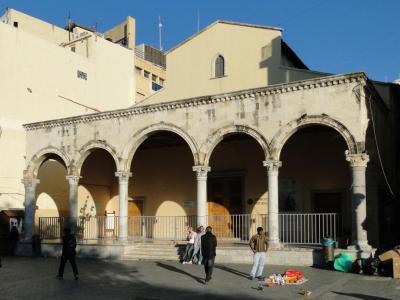Saint Mark's Basilica, Heraklion
The Basilica of Saint Mark stands proudly in Eleftheriou Venizelou Square, directly opposite the Lions Fountain. Dating back to the 13th century, precisely in 1239, the Venetians, seeking to fortify their dominion over Candia (modern-day Heraklion), and driven by a profound devotion to their homeland, erected the Basilica of Saint Mark. Dedicated to their patron saint, Saint Mark, the basilica served as a locus for official Venetian ceremonies and the final resting place for Venetian nobility.
The basilica's original design featured a straightforward layout with a covered portico, resembling the structure visitors encounter today. In 1956, the Society for Cretan Historical Studies undertook the significant task of restoring the building to its authentic form, preserving its historical essence.
At the southwest corner of the basilica, a towering structure housed a large clock facing Lions Square-a homage to Saint Mark's Basilica in Venice. This bell tower, modeled after its Venetian counterpart, became an integral part of the basilica's identity.
Over the centuries, the Basilica of Saint Mark weathered various earthquakes, withstanding the test of time with minimal repairs. However, during the Ottoman era, the basilica underwent a transformation into the Defterdar Mosque, named after Defterdar Ahmet Pasha, the Supreme Treasurer under Turkish rule. The Ottomans, in their alterations, dismantled the bell tower and erected a minaret in its place.
Today, the basilica serves a new purpose as the Municipal Art Gallery, welcoming visitors from near and far. Its doors are open almost daily, inviting exploration into the layers of history and cultural significance that define this venerable Venetian monument in the heart of Heraklion.
The basilica's original design featured a straightforward layout with a covered portico, resembling the structure visitors encounter today. In 1956, the Society for Cretan Historical Studies undertook the significant task of restoring the building to its authentic form, preserving its historical essence.
At the southwest corner of the basilica, a towering structure housed a large clock facing Lions Square-a homage to Saint Mark's Basilica in Venice. This bell tower, modeled after its Venetian counterpart, became an integral part of the basilica's identity.
Over the centuries, the Basilica of Saint Mark weathered various earthquakes, withstanding the test of time with minimal repairs. However, during the Ottoman era, the basilica underwent a transformation into the Defterdar Mosque, named after Defterdar Ahmet Pasha, the Supreme Treasurer under Turkish rule. The Ottomans, in their alterations, dismantled the bell tower and erected a minaret in its place.
Today, the basilica serves a new purpose as the Municipal Art Gallery, welcoming visitors from near and far. Its doors are open almost daily, inviting exploration into the layers of history and cultural significance that define this venerable Venetian monument in the heart of Heraklion.
Want to visit this sight? Check out these Self-Guided Walking Tours in Heraklion. Alternatively, you can download the mobile app "GPSmyCity: Walks in 1K+ Cities" from Apple App Store or Google Play Store. The app turns your mobile device to a personal tour guide and it works offline, so no data plan is needed when traveling abroad.
Saint Mark's Basilica on Map
Sight Name: Saint Mark's Basilica
Sight Location: Heraklion, Greece (See walking tours in Heraklion)
Sight Type: Religious
Guide(s) Containing This Sight:
Sight Location: Heraklion, Greece (See walking tours in Heraklion)
Sight Type: Religious
Guide(s) Containing This Sight:
Walking Tours in Heraklion, Greece
Create Your Own Walk in Heraklion
Creating your own self-guided walk in Heraklion is easy and fun. Choose the city attractions that you want to see and a walk route map will be created just for you. You can even set your hotel as the start point of the walk.
Heraklion Introduction Walking Tour
Legend tells that Heracles once set foot on Crete to capture the mighty Cretan Bull — a labor that tested both his strength and endurance. From that tale comes the name “Heraklion,” meaning “city of Heracles,” a fitting tribute to a place that has itself endured through centuries of change and conquest.
The area has been inhabited since the Neolithic era, but it first rose to... view more
Tour Duration: 2 Hour(s)
Travel Distance: 2.3 Km or 1.4 Miles
The area has been inhabited since the Neolithic era, but it first rose to... view more
Tour Duration: 2 Hour(s)
Travel Distance: 2.3 Km or 1.4 Miles




